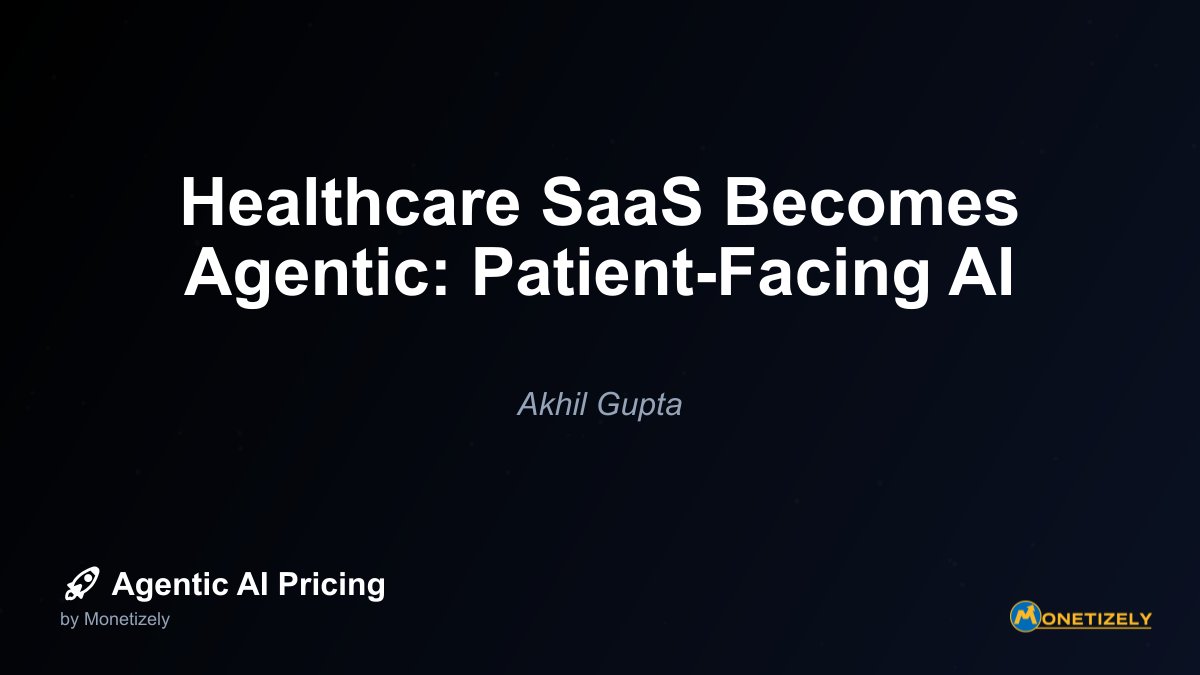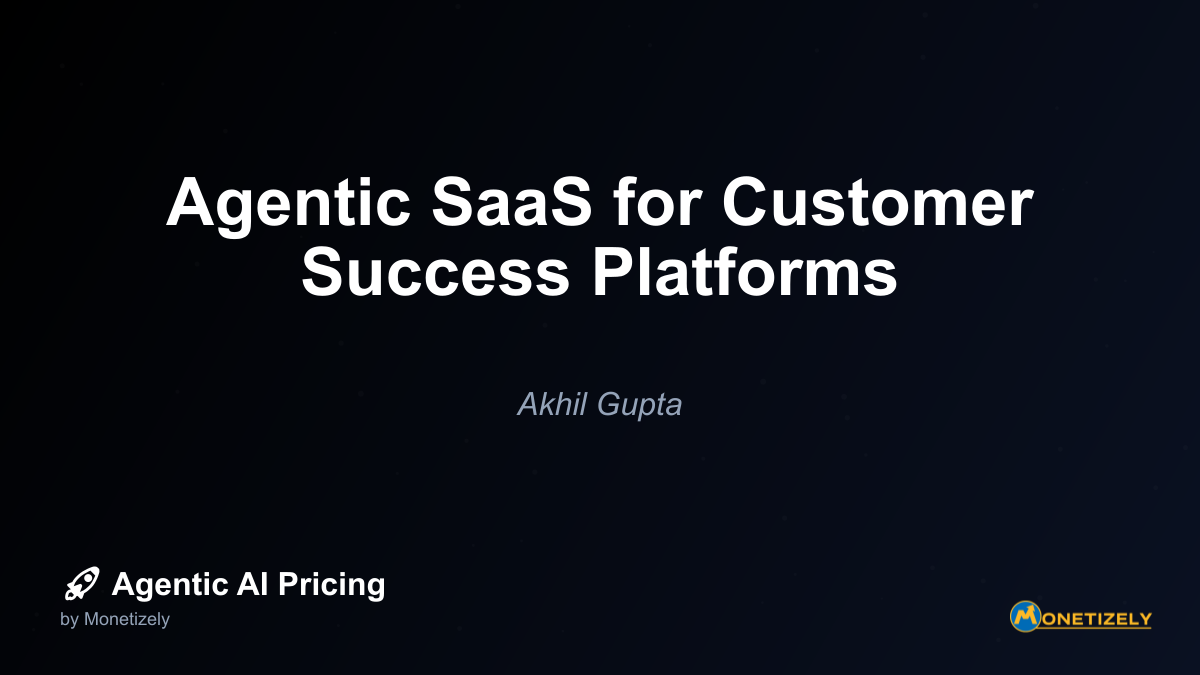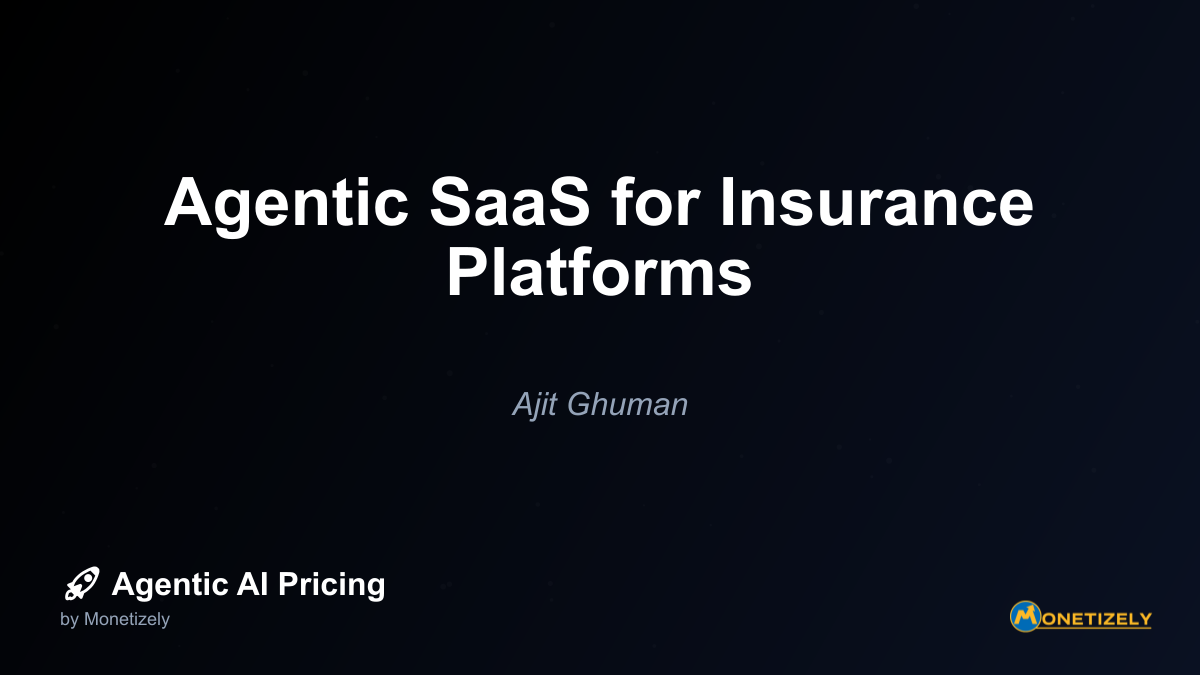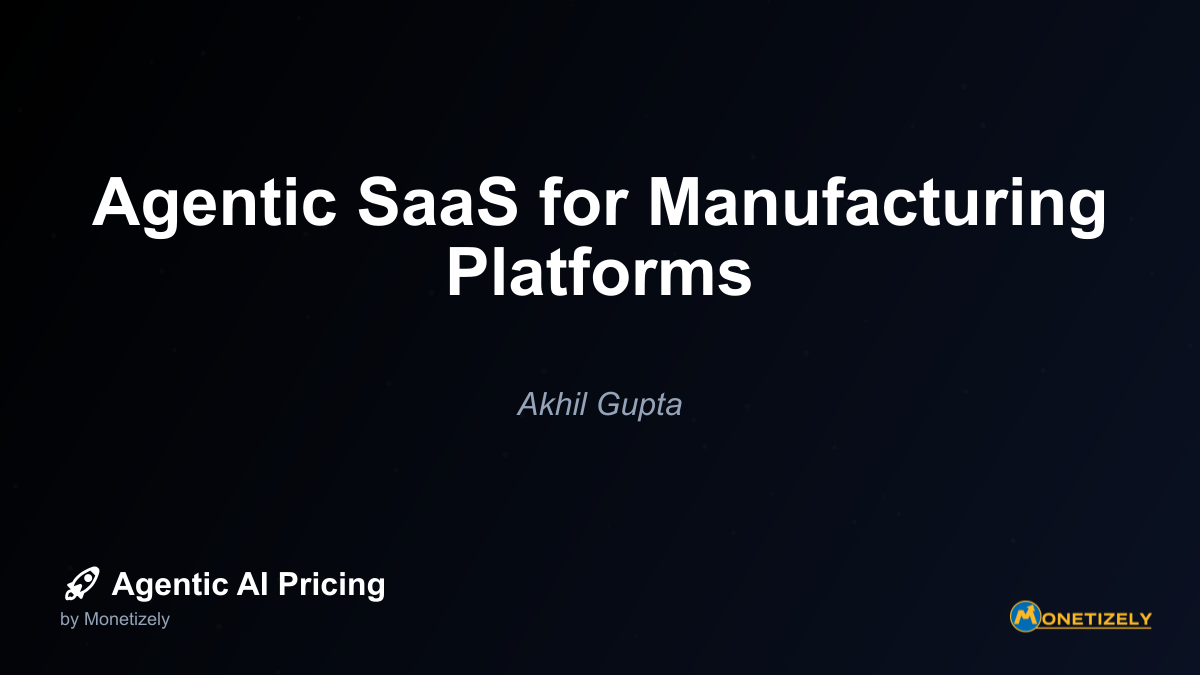· Akhil Gupta · Vertical Applications · 6 min read
Healthcare SaaS Becomes Agentic: Patient-Facing AI
AI and SaaS Pricing Masterclass
Learn the art of strategic pricing directly from industry experts. Our comprehensive course provides frameworks and methodologies for optimizing your pricing strategy in the evolving AI landscape. Earn a professional certification that can be imported directly to your LinkedIn profile.

Healthcare organizations are increasingly tying payments to measurable outcomes. For patient-facing agentic AI, this might include:
- Reduced readmission rates
- Improved medication adherence percentages
- Decreased no-show appointments
- Higher patient satisfaction scores
- Improved clinical outcomes for specific conditions
For example, a diabetes management AI agent might structure pricing based on average HbA1c improvements across the patient population. This aligns vendor incentives with healthcare goals and creates a compelling ROI narrative.
As explored in our guide How Much Does Healthcare AI Cost? Pricing and Regulatory Factors to Consider, outcome-based pricing requires careful measurement frameworks and contractual clarity around attribution.
Usage-Based Tiers with Value Metrics
While pure consumption-based pricing (per message or per interaction) can create misaligned incentives in healthcare, more sophisticated usage models are proving effective:
- Patient engagement levels (active monthly users)
- Interaction complexity tiers
- Care pathway completion rates
- Resolution rates without escalation
- Clinical documentation assistance volume
The key is selecting metrics that correlate with value creation rather than simply measuring activity. For instance, pricing based on “percentage of patient questions resolved without clinical staff involvement” directly connects to staff efficiency gains.
Hybrid Subscription + Success Fee Models
Many healthcare SaaS providers are adopting hybrid models with:
- Base subscription covering core functionality
- Success fees for specific outcomes or efficiencies
- Optional modules for specialized capabilities
- Volume-based pricing for certain high-value interactions
This approach provides predictable base revenue while creating upside potential tied to demonstrated value.
Risk-Sharing Partnerships
The most sophisticated pricing arrangements involve deeper risk-sharing between vendors and healthcare organizations:
- Shared savings from reduced care costs
- Co-investment in AI development for specific populations
- Gain-sharing from improved quality metrics
- Joint ventures with aligned incentives
These models require significant trust and data transparency but can create powerful long-term partnerships.
Implementation Challenges and Considerations
Despite the promise of patient-facing agentic AI, several important challenges must be addressed:
1. Data Privacy and Security
Healthcare data remains among the most sensitive and regulated information. Agentic AI systems must:
- Maintain strict HIPAA compliance
- Implement robust data governance frameworks
- Provide transparency about data usage
- Support patient consent management
- Implement appropriate access controls
Pricing models must account for these compliance requirements, which often increase development and operational costs.
2. Clinical Validation and Liability
Unlike consumer AI applications, healthcare systems can influence clinical decisions with significant consequences:
- Clinical validation requirements
- Ongoing monitoring for safety and effectiveness
- Clear escalation protocols
- Liability allocation between vendors and providers
- Appropriate disclaimers and limitations
These considerations affect how quickly new capabilities can be deployed and how pricing can evolve over time.
3. Integration Complexity
Healthcare IT environments remain notoriously fragmented:
- EHR integration requirements
- Identity management across systems
- Clinical workflow integration
- Data normalization challenges
- Legacy system constraints
Successful pricing strategies must account for these integration costs, which often exceed core development expenses.
4. Clinician Adoption and Trust
Even the most sophisticated AI systems require clinical oversight and acceptance:
- Transparent reasoning and recommendations
- Clinician review workflows
- Trust-building through accuracy demonstration
- Clear roles and responsibilities
- Professional education and training
Pricing should reflect the change management required for successful adoption.
5. Quantifying ROI Across Stakeholders
Healthcare value creation often spans multiple stakeholders:
- Provider organizations (efficiency, quality metrics)
- Payers (reduced costs, improved outcomes)
- Patients (convenience, health improvements)
- Clinicians (reduced burden, job satisfaction)
Effective pricing strategies must identify which stakeholder realizes which benefits and align payment responsibility accordingly.
Best Practices for Patient-Facing AI Pricing
Based on emerging patterns in the market, several best practices are becoming clear:
1. Start With Clear Value Metrics
Before establishing pricing, healthcare SaaS providers should:
- Identify specific efficiency gains (quantified in hours or FTEs)
- Calculate potential cost avoidance (readmissions, unnecessary visits)
- Measure quality improvement potential
- Assess patient satisfaction and engagement lift
- Quantify clinician time savings
These metrics become the foundation for value-based pricing discussions.
2. Implement Phased Pricing Evolution
Most successful implementations follow a staged approach:
- Initial pilot with limited risk-sharing
- Expanded deployment with defined success metrics
- Full implementation with outcome-based components
- Advanced partnership with deeper risk alignment
This progression builds trust while allowing both parties to refine measurement approaches.
3. Develop Sophisticated Measurement Frameworks
Outcome-based pricing requires robust measurement:
- Baseline establishment methodologies
- Control group comparisons where possible
- Statistical significance thresholds
- Attribution models for shared outcomes
- Regular reporting cadences
Investing in measurement infrastructure pays dividends in pricing power and customer trust.
4. Create Transparent Value Documentation
Healthcare organizations require detailed ROI justification:
- Case studies with similar organizations
- Peer-reviewed validation where available
- Total cost of ownership analyses
- Implementation timeline and resource requirements
- Expected time-to-value projections
This documentation supports internal champions during procurement processes.
5. Address Ethical Considerations Proactively
Patient-facing AI raises important ethical questions that pricing must address:
- Equity of access across patient populations
- Transparency about AI capabilities and limitations
- Appropriate human oversight provisions
- Continuous monitoring for bias or unexpected outcomes
- Clear responsibility delineation
Pricing structures should reflect these ethical commitments rather than undermining them.
The Future of Patient-Facing Agentic AI Pricing
As the market matures, several trends are likely to shape pricing evolution:
Ecosystem Integration
Rather than standalone applications, patient-facing AI will increasingly integrate with broader healthcare platforms:
- Embedded capabilities within EHR systems
- Integration with remote monitoring platforms
- Connections to payer systems and benefits
- Interoperability with pharmacy and lab services
- Coordination with home-based care services
This integration will influence pricing toward platform models rather than point solutions.
Specialization and Personalization
We’re already seeing the emergence of condition-specific AI agents:
- Diabetes management specialists
- Mental health support agents
- Maternal health coaches
- Chronic pain management assistants
- Medication adherence specialists
This specialization enables more precise outcome measurement and value-based pricing tied to condition-specific metrics.
Regulatory Evolution
As regulatory frameworks adapt to AI capabilities, pricing models will follow:
- Reimbursement pathways for AI-enabled care
- Liability frameworks that clarify responsibility
- Data governance standards that enable innovation
- Certification processes that validate safety
- Privacy frameworks that protect patients while enabling AI training
Successful pricing strategies will anticipate these regulatory developments.
Multi-Stakeholder Value Capture
The most sophisticated pricing models will span traditional healthcare boundaries:
- Shared savings arrangements with payers
- Patient subscription components for premium features
- Employer-sponsored access for workforce health
- Pharmaceutical partnerships for medication optimization
- Research collaborations that monetize anonymized insights
This multi-stakeholder approach reflects healthcare’s complex economic relationships.
Conclusion
Patient-facing agentic AI represents a transformative opportunity for healthcare organizations to improve care delivery, enhance patient engagement, and optimize resource utilization. The pricing models for these systems are evolving rapidly, moving beyond simple subscriptions toward sophisticated value-based arrangements that align incentives across stakeholders.
Successful healthcare SaaS providers will develop pricing strategies that:
- Clearly quantify and communicate value creation
- Align payment with meaningful outcomes
- Address implementation and integration realities
- Scale appropriately with demonstrated value
- Adapt to evolving regulatory requirements
As these systems become more capable, their pricing will increasingly reflect their role not just as software tools but as autonomous partners in care delivery. Organizations that master these pricing approaches will not only capture fair value for their innovations but also accelerate healthcare’s transformation toward more personalized, accessible, and effective patient care.
For healthcare leaders, the journey toward agentic AI adoption requires careful consideration of both the technology’s capabilities and the business models that sustain it. By understanding emerging pricing approaches, organizations can make informed decisions about which solutions offer sustainable value and how to structure partnerships that drive meaningful improvements in patient care.
Co-Founder & COO
Akhil is an Engineering leader with over 16+ years of experience in building, managing and scaling web-scale, high throughput enterprise applications and teams. He has worked with and led technology teams at FabAlley, BuildSupply and Healthians. He is a graduate from Delhi College of Engineering and UC Berkeley certified CTO.
Pricing Strategy Audit
Let our experts analyze your current pricing strategy and identify opportunities for improvement. Our data-driven assessment will help you unlock untapped revenue potential and optimize your AI pricing approach.




